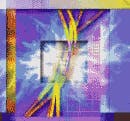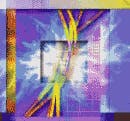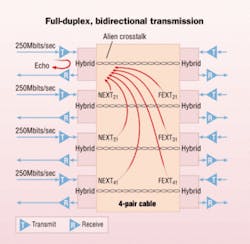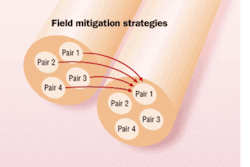The 802.3 Working Group of the IEEE LAN-MAN Standards Committee develops Ethernet standards. A new standard proposal is considered through a call for interest. If enough interest is demonstrated, a study group is formed to formulate a request for a standards project.
10GBase-T has established the interest. In a presentation in support of 10GBase-T, Bruce Tolley, manager of emerging technologies in Cisco Systems' Gigabit Systems Unit, cited the three principle issues in the slow growth of 10-Gigabit Ethernet over fiber as: 1) too expensive, 2) too expensive, and 3) too expensive.
Constrained by cost, the current 10-Gigabit market deployment is limited to link aggregation of multiple Gigabit Ethernet downlinks and point-to-point links for long-haul high-end applications. Although the data center—with networks of interconnected server clusters—can make best use of 10-Gigabit Ethernet, it is also the most cost-sensitive market. 10GBase-T is positioned to provide the lowest-cost solution for the broad range of 10-Gigabit Ethernet LAN applications and stimulate interest in lackluster 10-Gigabit Ethernet deployment.
The 10GBase-T study group is developing objectives and establishing the criteria to initiate a standards project. The road to Ethernet project approval is very difficult. The study group must convince 75% of the 802.3 Working Group membership that the proposal meets these five criteria:
- Broad market potential;
- Technical feasibility;
- Economic feasibility;
- Compatibility;
- Distinct identity.
10GBase-T cabling
There's an old saying that goes something like, "The only person who really enjoys a change is a baby with a wet diaper." End-users' resistance to changing their cabling infrastructure has been a key factor in the evolution of networking. The broad market penetration and acceptance of 10Base-T (10-Mbit/sec Ethernet) was due to its suitability for operation on the 100-Ω twisted-pair cabling installed to work-area wall outlets for telephony applications. The 10Base-T standard leveraged the use of the installed cabling infrastructure while providing significant data-rate improvements.
During the development of 10Base-T, the telecommunications industry recognized the need to standardize the cabling infrastructure to provide specifications for the cabling-system configurations. Structured cabling eliminated such telephony practices as bridged taps and splices, and introduced cabling topology requirements and cabling categories. Recognizing the benefits of a standardized cabling infrastructure, 10Base-T was revised to include a reference to ANSI/TIA/EIA-568A-1995. ‰
Telecommunications cabling standards (e.g., TIA/EIA-568A and ISO/IEC-11801) have continued to evolve to accommodate the Ethernet evolution by creating complementary specifications. A recent example of the dynamic between Ethernet standardization and the cabling standards evolution is the creation of Category 5e to support 1000Base-T.
The 10GBase-T study group is investigating the performance of Category 5e and Category 6 channel performance extending beyond the frequencies currently specified. The initial range of interest for frequency characterization is:
1 MHz <= f <= 625 MHz.
In addition, the study group is investigating alien crosstalk impairments. Alien crosstalk is noise coupled between adjacent four-pair cables and connectors. In this effort, the study group has requested the assistance of TIA TR-42—the Engineering Committee on User Premises Telecommunications Cabling Infrastructure.
Alien crosstalk
Full-duplex, bidirectional transmission consists of transmitting and receiving data simultaneously in both directions on each of the four wire pairs. Hybrid circuits are needed to enable bidirectional transmission over single wire pairs. Bidirectional transmission allows far-end crosstalk to combine with near-end crosstalk and echo at the receiver.
Digital signal processing (DSP) cancellation techniques can reduce the effect of these impairments on the receiver. The characteristics of the impairment signals are learned in order to implement the necessary cancellation. Since the symbols transmitted by the disturbing transmitter are available to the cancellation processor, the noise can be suppressed by generation of cancellation filters. The filter characteristics are constructed from the signals received from the transmitters.
Because alien crosstalk is noise generated from transmitters external to the four-pair channel being affected, the transmitted symbols from the noise source are not available to the cancellation processor—they are in another cable. Therefore, it is difficult to suppress the alien crosstalk. Much of the debate on the technical feasibility of 10GBase-T centers on the suppression and mitigation of alien crosstalk.
Mitigation efforts
The 10GBase-T study group is evaluating the crosstalk between adjacent four-pair cables and patch cords, as well as the crosstalk between adjacent patch-panel ports, to determine their impact on the 10GBase-T channel capacity (achievable data rate).
Given the difficulty of suppressing alien crosstalk through DSP, it is likely that the study group will consider developing specifications and field-mitigation recommendations that address the 10GBase-T deployment on installed cabling.
Possible field-mitigation strategies include:
- Separation of cables and patch cords to reduce the amount of coupling between adjacent four-pair cables;
- Addition of longer patch cables to reduce the coupling voltage and to reduce the coupled noise that appears back at the receiver;
- Separation of 10GBase-T ports on the patch panel;
- Limiting the number of 10GBase-T channels in bundled cable and conduit;
- Replacement of connectors or patch panels.
Other possibilities for alien crosstalk mitigation include taking advantage of the margin over worst-case typical of much of the installed cabling. Given the recommendations in TIA/EIA-569B concerning the placement of the telecommunications room in relation to the floor area served, the horizontal cable distances are typically much less than 100 meters. Insertion loss scales as a function of length, so the shorter distances have insertion-loss margin over the worst case.
Validation of 10GBase-T operation on the customer's installed cabling through field measurement and calculations of the insertion-loss-to-noise ratio are certainly plausible, given the sophistication and functionality of the available handheld field test equipment. A note of caution here: Cabling field-test tools generally perform their measurements by communicating between a main unit and a remote unit on the same four-pair cabling link. The alien-crosstalk measurement is taken between the four-pair cabling links, presenting a challenge to current tools and field-measurement practices.
10GBase-T will continue the historic dynamic between Ethernet standardization and the cabling standards evolution. If 10GBase-T is to progress as a standard, it must be proven to support a large percentage of the Category 5e and Category 6 installed cable plant. In addition, new cabling specifications will certainly evolve to support 100% coverage for the 10GBase-T application.
Chris DiMinico is president of MC Communications and a member of both the IEEE 802.3 Working Group and the TIA TR-42 Engineering Committee. He is chairman of the 802.3 10GBase-T Ad Hoc Cabling Group, and co-chair of the subcommittee developing the new TR-42 data center standard.



